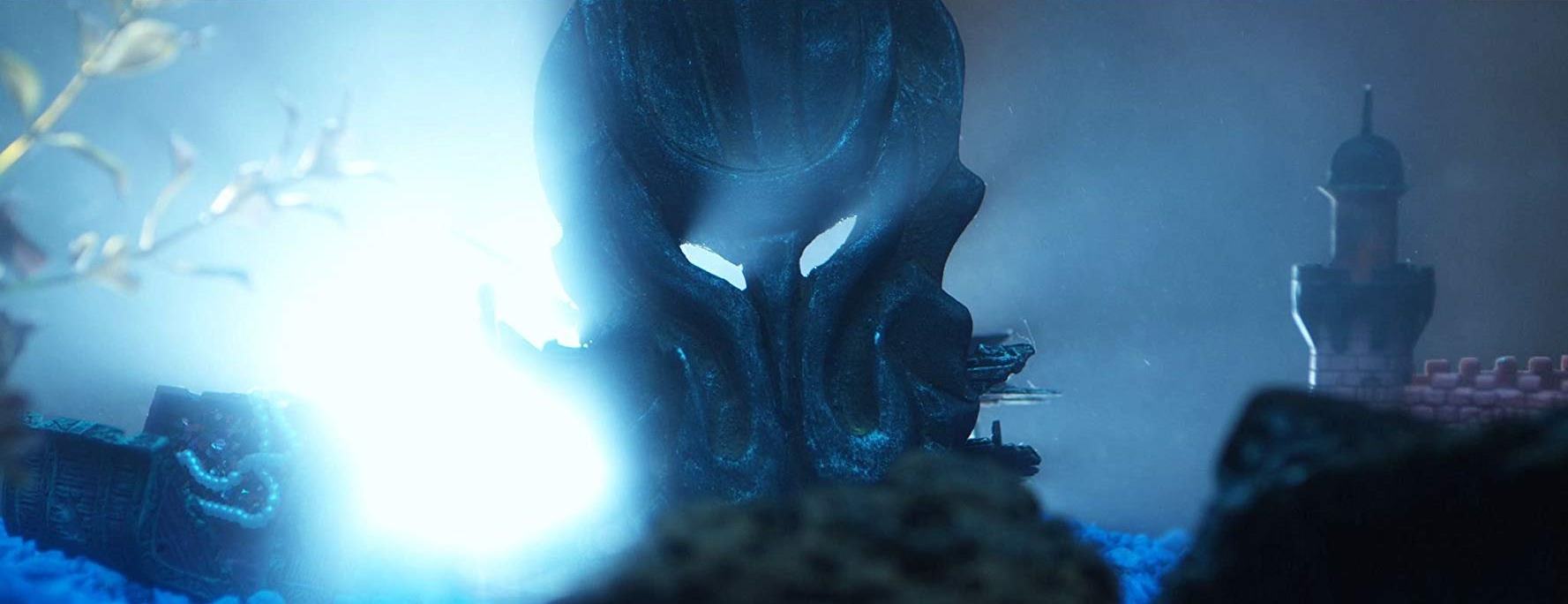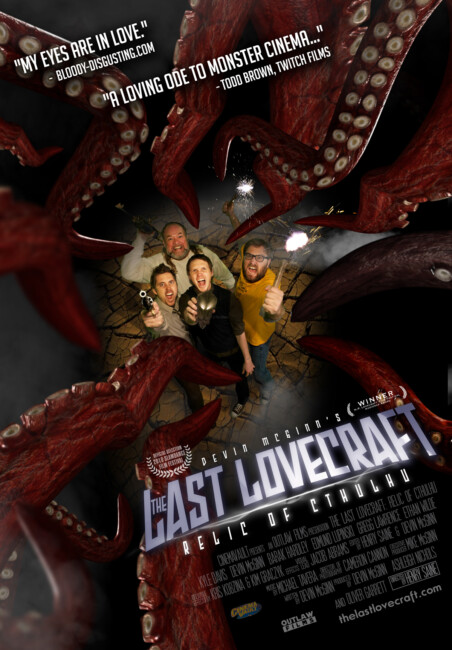Crew
Director/Animation Sequence – Henry Saine, Screenplay – Devin McGinn, Producers – Oliver Garrett, Devin McGinn & Ashleigh Nichols, Photography – Cameron Cannon, Music – Michael Tavera, Visual Effects Supervisor – Jacob Abrams, Creature Effects – Kim Graczyk & Kris Kobzina, Art Direction – Nikki Rudloff & Henry Saine. Production Company – Outlaw Films.
Cast
Kyle Davis (Jeff Phillips), Devin McGinn (Charlie Russell), Barak Hardley (Paul Reamer), Gregg Lawrence (Captain Olaf), Ethan Wilde (Starspawn), Harry Karp (Jimbo), Edmund Lupinski (Professor Lake), Martin Starr (Clarence), Richard Reihle (Mr Snodgrass), Robert Eaton (Gary), Charles Haigh (Council Leader), Ellen Pederson (Nanna Reamer)
Plot
Professor Lake of the Miskatonic University is summoned by the secret Council of Cthulhu and informed that Cthulhu cultists have uncovered an important relic. He is assigned to deliver the sister relic into the hands of the last descendent of H.P. Lovecraft to ensure that the two pieces are not brought together, which would allow Cthulhu to be raised from where he is buried in the lost city of R’yleh on the ocean floor. The last Lovecraft descendent is Jeff Phillips, an average frustrated guy in his twenties who works for Sqrly Gifts. He and best friend Charlie Russell return home to find Lake waiting, although Jeff thinks Lake’s talk about Cthulhu and the Elder Gods is crazy. Moments later, tentacled fish people burst into the house and kill Lake. Jeff and Charlie flee, seeking the company of Paul Reamer, an ultra-nerdy school friend who was obsessed with Lovecraft. The three set out to follow a map that leads the way to Captain Olaf, a sailor who once encountered a Deep One. All along the way they are pursued by the Cthulhu cultists and the monstrous Starspawn who want to obtain the relic.
It was Kevin Smith who gave the nerd comedy its legs with Clerks. (1994) and the cult that followed his subsequent films. Smith’s films frequently feature nerds and frustrated chumps hanging onto adolescence and making wry asides about aspects of pop culture, in particular Star Wars fandom. It was not long after this that various aspects of science-fiction and fantastic fandom started to build on what Smith had created, charting the lives of science-fiction fans. These included the likes of Free Enterprise (1998) and GalaxyQuest (1999) centring around Star Trek fandom, as well as the Trekkies (1997) and Trekkies 2 (2004) documentaries that charted the oddities of the Star Trek fan phenomenon; Mark Hamill’s mockumentary Comic Book: The Movie (2004) and Morgan Spurlock’s more straight-faced documentary Comic-Con Episode IV: A Fan’s Hope (2011) both set around the San Diego Comic-Con; Proxima (2007) where a science-fiction fan is taken on an intergalactic adventure; Fanboys (2008) about Star Wars fans; Frequently Asked Questions About Time Travel (2009) with fans caught up in a time travel adventure; Paul (2011) about science-fiction fans encountering a real alien; Rise of the Fellowship (2013) about Lord of the Rings fans and gamers; even an entire tv series The Big Bang Theory (2007-19) set around fans and fannish in-jokes.
The Last Lovecraft: Relic of Cthulhu chooses as its focus the works of horror writer H.P. Lovecraft. Howard Phillips Lovecraft had a brief writing career (from 1916 until his death in 1937) but in that time managed to create a body of work that has inspired a cult. Lovecraft’s prose brims with a unique sense of cosmic horror – of Earth existing as a tiny island surrounded by unbelievably powerful ancient gods waiting to return, lost cities, arcane rites, scientists whose quest for knowledge has taken them too far and individuals driven insane by sights and horrors so unimaginable they can only be depicted as ‘indescribable’. (For a more detailed overview see Lovecraftian Films).
There is much potential in his works, although there does seem to be something forced in attempting to make a fanboy comedy about H.P. Lovecraft – it is not as though Lovecraft has a fanatical following or entire conventions centred around his works as is the case with Star Trek and Star Wars, at most you might get the odd panel at a convention discussing Lovecraft’s work. Although there do seem to be a surprising number of amateur filmmakers dedicated to making Lovecraft-based films – see The H.P. Lovecraft Film Festival – North (1999) for one such example, while a few years earler we had another Lovecraft fan parody/tribute film with Lovecracked: The Movie (2006) and there was the subsequent Call Girl of Cthulhu (2014).

There are two different ways to read The Last Lovecraft: Relic of Cthulhu – either as a fanboy comedy or as an H.P. Lovecraft film. As a fanboy comedy, The Last Lovecraft has its undeniable amusements – gags about trying to pry the sucker tips of fish people off the passenger window of a car to make a getaway; or the scenes training in the backyard with Barak Hardley playing the role of Cthulhu with a cardboard mask and multiple green inflatable sports shakers for tentacles.
There are some mildly amusing one-liners tossed off – Barak Hardley recoils from the offer to join the expedition “I’m not ready to roll the D9” or his pissed-off friend Martin Starr threatening “I’ll never be your dungeonmaster again.” The two lead characters played by Kyle David and writer/producer Devin McGinn are okay, although the scene-stealer of the film proves to be Barak Hardley who gives a fine performance as the overgrown adolescent tentatively setting out into the world.
The Kevin Smith/fanboy comedy does seem an odd fit when transplanted into the world of H.P. Lovecraft, which almost always centres around people discovering artifacts and ancient monsters from beyond time or unleashing mutations and potentially nightmarish terrors. The typical H.P. Lovecraft story ends with the narrator driven insane by the things they have encountered. All of that said, The Last Lovecraft: Relic of Cthulhu does a fair job of approximating the basics of Lovecraft. Almost all of the mainstream Lovecraft adaptations borrow bits of Lovecraft, make occasional references to his mythos and offer even less occasional glimpses of the intensely paranoid mood that the Lovecraft cult loves. In fact, the amateur Lovecraft films do a far better job of capturing the essence of Lovecraft than most of the professional Lovecraft adaptations do.

The Last Lovecraft is short on intensely paranoid mood – a large part due to its taking a comedy focus – although does offer up a cheaply animated potted encapsulation of the backstory of Cthulhu and the Elder Gods that holds far more of the Cthulhu mythos than all of the professional productions put together. (See below for a full list of H.P. Lovecraft adaptations). That said, you cannot help but feel that H.P. Lovecraft, a noted conservative whose fiction you could read in vain searching for a sense of humour, would probably be turning in his grave at the thought of a fanboy comedy based on his writings.
On the other side of the coin, The Last Lovecraft leaves much to be desired as an H.P. Lovecraft film. The Lovecraftian creations that we get are no more than B-budget monster masks and occasional gore effects. The Starspawn seems singularly lacking in cosmic horror and nothing more than a villain in a red-faced monster mask – shades of Red Skull in Captain America (1990) – making threats and despatching his minions. The animated sequence where Cthulhu starts to return to life in the undersea city of R’yleh is particularly cheap.
This was the first film from director Henry Saine who had previously worked in music video and as a storyboard artist. Saine later co-wrote a comic-book and adapted into the entertainingly over-the-top post-apocalyptic action film Bounty Killer (2013). Screenwriter Devin McGinn later went on to co-direct the Found Footage film Skinwalker Ranch (2013).
Other films based on the works of H.P. Lovecraft include:- The Haunted Palace (1963), Die, Monster, Die/Monster of Terror (1965), The Shuttered Room (1967) and The Dunwich Horror (1969). The big success in the modern era was Stuart Gordon’s splattery black comedy version of Re-Animator (1985), which popularised Lovecraft on film. This led to a host of B-budget Lovecraft adaptations, including Stuart Gordon’s subsequent From Beyond (1986), The Curse (1987), The Unnameable (1988), The Resurrected (1992), Necronomicon (1993), The Unnamable II: The Statement of Randolph Carter (1993), Lurking Fear (1994), Gordon’s Dagon (2001), and other works such as The Dream-Quest of Unknown Kadath (2003), Beyond the Wall of Sleep (2006), Cool Air (2006), Chill (2007), Cthulhu (2007), The Tomb (2007), Colour from the Dark (2008), The Dunwich Horror (2009), The Color (2010), Pickman’s Muse (2010), The Whisperer in Darkness (2011), The Dark Sleep (2013), The Haunter of the Dark (2015), Herbert West: Re-Animator (2017), Color Out of Space (2019), H.P. Lovecraft’s The Deep Ones (2020), the tv series Lovecraft Country (2020), Markham (2020), H.P. Lovecraft’s Witch House (2021), The Resonator: Miskatonic U (2021), The Lurking Fear (2023), Suitable Flesh (2023), H.P. Lovecraft’s The Old Ones (2024) (2024), The Innsmouth School for Girls (2024) and Unspeakable: Beyond the Wall of Sleep (2024). Lovecraft: Fear of the Unknown (2008) is a documentary about Lovecraft. Also of interest is The Manitou (1978), which features an appearance of the Great Old One; Cast a Deadly Spell (1991) and its sequel Witch Hunt (1994), a tv movie set in an alternate world where magic works and where the central character is a detective named H.P. Lovecraft; Juan Piquer Simon’s cheap and loosely inspired Cthulhu Mansion (1992); John Carpenter’s Lovecraft homage In the Mouth of Madness (1995); the fan parodies Lovecracked: The Movie (2006) and Call Girl of Cthulhu (2014); even a trilogy of animated children’s film Howard Lovecraft and the Frozen Kingdom (2016), Howard Lovecraft and the Undersea Kingdom (2017) and Howard Lovecraft and the Kingdom of Madness (2018) in which a young Lovecraft encounters his own creations; while Batman faces Lovecraftian horrors in the animated Batman: The Doom That Came to Gotham (2023); and Lovecraft homages such as The Breach (2022), H.P. Lovecraft’s Monster Portal (2022) and Gods of the Deep (2023). The Elder Gods turn up at the end of The Cabin in the Woods (2012), Lovecraft (Paul Titley) appears as an imaginary companion in Ghostland/Incident in a Ghostland (2018) and In Search of Lovecraft (2008) features a tv news crew discovering that Lovecraft’s works are true. Lovecraft’s key work of demonic lore The Necronomicon also makes appearances in films such as Equinox (1970), The Evil Dead II (1987) and Army of Darkness (1992), and was also borrowed as an alternate retitling for Jesus Franco’s surreal and otherwise unrelated Succubus/Necronomicon (1969) about a BDSM dancer.
Trailer here


